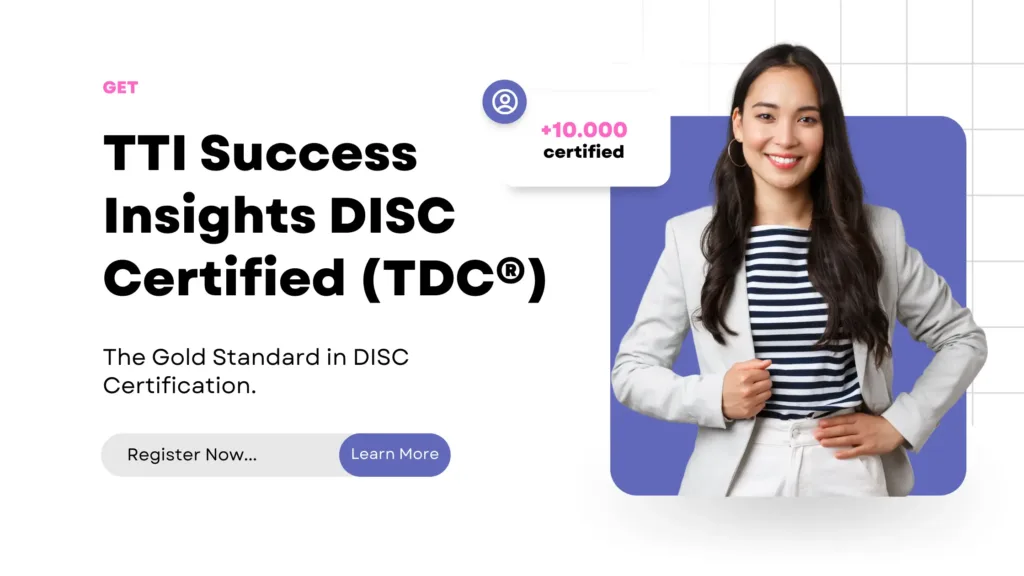Enhancing Team work with DISC: Strategies for Building Trust and Unity

In the complex dynamics of modern workplaces, trust serves as the backbone, uniting diverse talents into cohesive, high-performing teams. Harnessing the DISC model—Dominance, Influence, Steadiness, Compliance—can revolutionize our understanding of team interactions, facilitating a culture where trust is not merely present but foundational. Here’s how integrating Team work with DISC, Team Building with DISC, and DISC Team Version into your strategies can transform group dynamics and foster an environment of understanding and respect.
A Guide to Team Dynamics using DISC
The DISC model plays a pivotal role in enhancing team interactions and performance by categorizing individuals into four primary behavioral styles. Understanding these styles can lead to more effective communication, better role alignment, and a more cohesive team environment. Here’s a deeper look into each DISC type with examples that illustrate how they contribute to team success:
Dominance (D-types): Visionary and Decisive
Dominance types are characterized by their assertiveness and desire to lead. They are quick decision-makers, often thriving in environments where they can set ambitious goals and take charge of achieving them.
In a project team, a D-type might be the one who outlines a bold new strategy for a product launch. They would take the lead in steering the team meetings, making decisive choices, and pushing the team to meet tight deadlines. Their assertive nature ensures that the project moves forward swiftly and efficiently, even when faced with challenges.
Influence (I-types): Charismatic and Enthusiastic
People with the Influence style are the energizers within the team. They are naturally charismatic and excel in roles that require interaction and motivation of others. Their enthusiasm is infectious, which helps in building and maintaining high team morale.
An I-type team member could shine in client-facing roles or when rallying the team around a new initiative. For instance, during a team offsite, they might be the ones leading a group activity, engaging everyone with their vibrant personality and ensuring that all team members feel included and valued.

Steadiness (S-types): Reliable and Supportive
Steadiness types are the stabilizing force in any team. They are highly valued for their dependability, patience, and supportive nature. S-types excel in environments where they can provide consistent support and help maintain a harmonious team dynamic.
In a scenario where a team is under stress due to impending deadlines or project complexities, an S-type might be the team member who stays calm, offering support where needed. They might handle the logistical aspects of the project, ensuring that everyone has what they need and that operations run smoothly, thus stabilizing team operations during turbulent times.
Compliance (C-types): Analytical and Methodical
Compliance types are focused on accuracy and logic. They are meticulous planners and are crucial in roles that require attention to detail and adherence to standards. Their methodical approach ensures that projects are not only completed but are done so with a high level of precision.
A C-type team member might be in charge of quality control for a new software development project. They would meticulously review each line of code or test scenarios to ensure that the product meets the required standards before it goes to market. Their analytical skills make them adept at identifying potential issues that others might overlook.
By leveraging these diverse DISC styles, teams can harness the unique strengths of each member, leading to better outcomes and a more fulfilling work environment. Each style plays a crucial role in balancing team dynamics, ensuring that leadership, enthusiasm, stability, and precision coexist harmoniously within the group.

Key Strategies – Team work with DISC
Harness DISC for Synergistic Team Building
By understanding and leveraging the unique strengths of each DISC type, teams can transform individual capabilities into collective success. This approach not only boosts performance but also cultivates a respectful and mutually supportive environment.
Enhance Communication with DISC Adaptation
Tailor communication strategies to match the DISC profiles, crafting messages that resonate with each personality type. This tailored approach helps in building trust and ensuring that all team members feel valued and understood.
Foster Empathy with DISC Insights
Use DISC to delve into the underlying motivations and fears of team members, promoting a culture of empathy. This understanding helps in addressing personal and professional challenges more effectively, enhancing team cohesion.
Align Roles with DISC Profiles
Optimize productivity and job satisfaction by aligning roles and responsibilities with the inherent strengths of each DISC type. This strategic alignment leads to improved efficiency and a more harmonious workplace.
Strengthen Teams with DISC-Enhanced Activities
Design team-building activities that cater to the strengths and preferences of different DISC profiles, fostering a deeper understanding and appreciation of each member’s unique contributions.
Promote Openness with DISC-Responsive Communication
Create a supportive atmosphere that respects the communication preferences of each DISC type, fostering a culture of transparency and open dialogue.
Commit to Continuous Learning and Development
Tailor growth and development opportunities to the needs of each DISC profile, supporting continuous improvement and helping each team member reach their full potential.
Conclusion
Understanding and applying the principles of DISC can significantly enhance team dynamics, making “Team work with DISC,” “Team Building with DISC,” and “DISC Team Version” essential components of modern team management strategies. These approaches not only improve communication and collaboration but also build a resilient foundation of trust and mutual respect, leading to sustained organizational success.